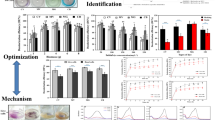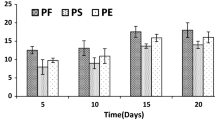Abstract
The dye decolorization potential of the white-rot fungus Phlebia brevispora TMIC33929 when grown alone or in coculture with its growth-promoting bacterium Enterobacter sp. TN3W-14 was evaluated in low nitrogen liquid medium at different pHs. Axenic fungus removed a similar amount of Congo red and crystal violet at pH 4.5 and 7.0, respectively. The bacterium alone achieved only slightly better decolorization of crystal violet than the fungus at pH 9.0. Compared with axenic fungus, cocultures provided no increased crystal violet removal but achieved higher removal of crystal violet in mixed dye at all pHs, and the best-mixed dye decolorization at pH 9.0. Unlike bacterial growth on dyes, growth of fungal mycelia was not inhibited by the dyes at all pH but the cocultures gave comparably higher mycelial growth.





Similar content being viewed by others
References
Jin, X. C., Liu, G. Q., Xu, Z. H., & Tao, W. Y. (2007). Decolorization of a dye industry effluent by Aspergillus fumigatus XC6. Applied Microbiology and Biotechnology, 74(1), 239–243.
Nozaki, K., Beh, H. C., Mizuno, M., Isobe, T., Shiroishi, M., Kanda, T., & Amano, Y. (2008). Screening and investigation of dye decolorization activities of Basidiomycetes. Journal of Bioscience and Bioengineering, 105(1), 69–72.
Reife, A., & Othmer, K. (1993). Encyclopedia of chemical technology (Vol. 8, 4th ed.). New York: Wiley.
Cripps, C., Bumpus, J. A., & Aust, S. D. (1990). Biodegradation of azo dyes by Phanerochaete chrysosporium. Applied and Environmental Microbiology, 56(4), 1114–1118.
Woo, S. W., Cho, J. S., Hur, B. K., Shin, D. H., Ryu, K. G., & Kim, E. K. (2003). Hydrogen peroxide, its measurement and effect during enzymatic decoloring of Congo red. Journal of Microbiology and Biotechnology, 13, 773–777.
Klaus, H., Peter, M., Wolfgang, R., Roderich, R. K., & Kunde, A. E. (2005). Azo dyes. In Ullmann’s encyclopedia of industrial chemistry. Weinheim: Wiley-VCH.
Littlefield, N. A., Blackwell, B. N., Hewitt, C. C., & Gaylor, D. W. (1985). Chronic toxicity and carcinogenicity studies of gentian violet in mice. Fundamental and Applied Toxicology, 5(5), 902–912.
Saratale, R. G., Saratale, G. D., Chang, J. S., & Govindwar, S. P. (2011). Bacterial decolorization and degradation of azo dyes: A review. Journal of the Taiwan Institute of Chemical Engineers, 42(1), 138–157.
Pandey, A., Singh, P., & Iyengar, L. (2007). Bacterial decolorization and degradation of azo dyes. International Biodeterioration and Biodegradation, 59(2), 73–84.
Stolz, A. (2001). Basic and applied aspects in the microbial degradation of azo dyes. Applied Microbiology and Biotechnology, 56(1-2), 69–80.
Banat, I. M., Nigam, P., Singh, D., & Marchant, R. (1996). Microbial decolorization of textile-dyecontaining eluents: a review. Bioresource Technology, 58(3), 217–227.
Slokar, Y. M., & Le Marechal, A. M. (1998). Methods of decoloration of textile wastewaters. Dyes and Pigments, 37(4), 335–356.
Franciscon, E., Zille, A., Garboggini, F. F., Silva, I. S., Paulo, A. C., & Durrant, L. R. (2009). Microaerophilic-aerobic sequential decolourization/biodegradation of textile azo dyes by a facultative Klebsiella sp. strain VN-31. Process Biochemistry, 44(4), 446–452.
Kalyani, D. C., Telke, A. A., Dhanve, R. S., & Jadhav, J. P. (2008). Ecofriendly biodegradation and detoxification of reactive red 2 textile dye by newly isolated Pseudomonas sp. SUK1. Journal of Hazardous Materials, 163(2-3), 735–742.
Knapp, J. S., Vantoch-Wood, E. J., & Zhang, F. (2001). In G. M. Gadd (Ed.), Fungi in bioremediation. Cambidge: Cambidge University Press.
Rajaguru, P., Kalaiselvi, K., Palanivel, M., & Subburam, V. (2000). Biodegradation of azo dyes in a sequential anaerobic-aerobic system. Applied Microbiology and Biotechnology, 54(2), 268–273.
Panswad, T., Iamsamer, K., & Anotai, J. (2001). Decolorization of azo-reactive dye by polyphosphate- and glycogen-accomulating organisms in an anaerobic-aerobic sequencing batch reactor. Bioresource Technology, 76(2), 151–159.
Chang, J. S., Chou, C., & Chen, S. Y. (2001). Decolorization of azo dyes with immobilized Pseudomonas luteola. Process Biochemistry, 36(8-9), 757–763.
Lourenco, N. D., Novais, J. M., & Pinheiro, H. M. (2001). Effect of some operational parameters on textile dye biodegradation in a sequential batch reactor. Journal of Biotechnology, 89(2-3), 163–174.
McMullan, G., Meehan, C., Conneely, A., Kirby, N., Robinson, T., Nigam, P., Banat, I. M., Marchant, R., & Smyth, W. F. (2001). Microbial decolorization and degradation of textile dyes. Applied Microbiology and Biotechnology, 56(1-2), 81–87.
Pointing, S. B. (2001). Feasibility of bioremediation by white-rot fungi. Applied Microbiology and Biotechnology, 57(1-2), 20–33.
Abadulla, E., Tzanov, T., Costa, S., Robra, K. H., Artur, C. P., & Gubitz, G. M. (2000). Decolorization and detoxification of textile dyes with a laccase from Trametes hirsuta. Applied and Environmental Microbiology, 66(8), 3357–3362.
Borchert, M., & Libra, J. A. (2001). Decolorization of reactive dyes by the white-rot fungus Trametes versicolor in sequencing batch reactors. Biotechnology Bioengineering, 75(3), 313–321.
Harry-asobara, J. L., & Kamei, I. (2018). Bacterial strains isolated from Cedar wood improve the mycelial growth and morphology of white rot fungus Phlebia brevispora on agar and liquid medium. Journal of Wood Science, 64(4), 444–450.
Kamei, I., Sonoki, S., Haraguchi, K., & Kondo, R. (2006). Fungal bioconversion of toxic polychlorinated biphenyls by white-rot fungus Phlebia. brevispora. Applied Microbiology and Biotechnology, 73(4), 932–940.
Kamei, I., Suhara, H., & Kondo, R. (2005). Phylogenetical approach to isolation of white-rot fungi capable of degrading polychlorinated dibenzo-p-dioxin. Applied Microbiology and Biotechnology, 69(3), 358–366.
Xiao, P., Mori, T., Kamei, I., & Kondo, R. (2011). Metabolism of organochlorine pesticide heptachlor and its metabolite heptachlor epoxide by white rot fungi belonging to genus Phlebia. FEMS Microbiology Letters, 314(2), 140–146.
Kirk, T. K., Yang, H. H., & Keyser, P. (1977). The chemistry and physiology of the fungal degradation of lignin. Journal of Industrial Microbiology, 19, 51–61.
Anliker, R. (1979). Ecotoxicology of dyestuffs-a joint effort by industry. Ecotoxicology and Environmental Safety, 3(1), 59–74.
Michaels, G. B., & Lewis, D. L. (1986). Microbial transformation rates of AZO and triphenylmethane dyes. Environmental Toxicology and Chemistry, 5(2), 161–166.
Zimmerinan, T., Kulla, H. G., & Leisinger, T. (1982). Properties of purified Orange II azoreductase, the enzyme initiating azo dye degradation by Pseudomonas KF46. European Journal of Biochemistry, 129(1), 197–203.
Singh, R. P., Singh, P. K., & Singh, R. L. (2014). Bacterial decolorization of textile azo dye acid orange by Staphylococcus hominis RMLRT03. Toxicology International, 21(2), 160–166.
Rani, B., Kumar, V., Singh, J., Bisht, S., Teotia, P., Sharma, S., & Ritu, K. (2014). Bioremediation of dyes by fungi isolated from contaminated dye effluent sites for bio-usability. Brazilian Journal of Microbiology, 45(3), 1055–6310.
Vasdev, K. (2011). Decolorization of triphenylmethane dyes by six white-rot fungi isolated from nature. Journal of Bioremediation and Biodegradation, 2(05), 128. https://doi.org/10.4172/2155-6199.1000128.
Eun-Hee, P., Jang, M., Cha, I., Choi, Y., CHO, Y., Kim, C., & Lee, Y. (2005). Decolorization of a sulfonated azo dye, Congo red, by Staphylococcus sp. EY-3. Journal of Microbiology and Biotechnology, 15(1), 221–225.
Selva Raj, D., Jaisy Prabha, R., & Leena, R. (2012). Analysis of bacterial degradation of azo dye Congo red using HPLC. Journal of Industrial Pollution Control, 28(1), 57–62.
Pearce, C. I., Loyd, J. R., & Guthrie, J. T. (2003). The removal of colour from textile wastewater using whole bacterial cells: a review. Dyes and Pigments, 58(3), 179–196.
Yesiladal, S. K., Pekin, G., Bermek, H., Arslan-Alaton, İ., Orhon, D., & Tamerler, C. (2006). Bioremediation of textile azo dyes by Trichophyton rubrum LSK-27. World Journal of Microbiology and Biotechnology, 22(10), 1027–1031.
Acknowledgments
We thank Edanz Group (www.edanzediting.com/ac) for editing a draft of this manuscript.
Funding
This work was supported in part by a Grant-in-Aid for Scientific Research from the Ministry of Education, Culture, Sports, Science and Technology of Japan (grant no. 18H02257 and 17K19296).
Author information
Authors and Affiliations
Corresponding author
Ethics declarations
Conflict of Interest
The authors declare that they have no conflicts of interest.
Additional information
Publisher’s Note
Springer Nature remains neutral with regard to jurisdictional claims in published maps and institutional affiliations.
Rights and permissions
About this article
Cite this article
Harry-asobara, J.L., Kamei, I. Characteristics of White-rot Fungus Phlebia brevispora TMIC33929 and Its Growth-Promoting Bacterium Enterobacter sp. TN3W-14 in the Decolorization of Dye-Contaminated Water. Appl Biochem Biotechnol 189, 1183–1194 (2019). https://doi.org/10.1007/s12010-019-03062-6
Received:
Accepted:
Published:
Issue Date:
DOI: https://doi.org/10.1007/s12010-019-03062-6




